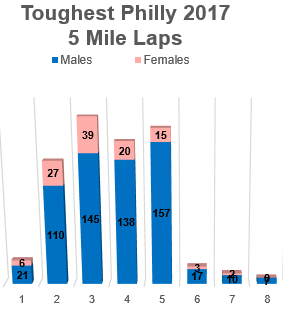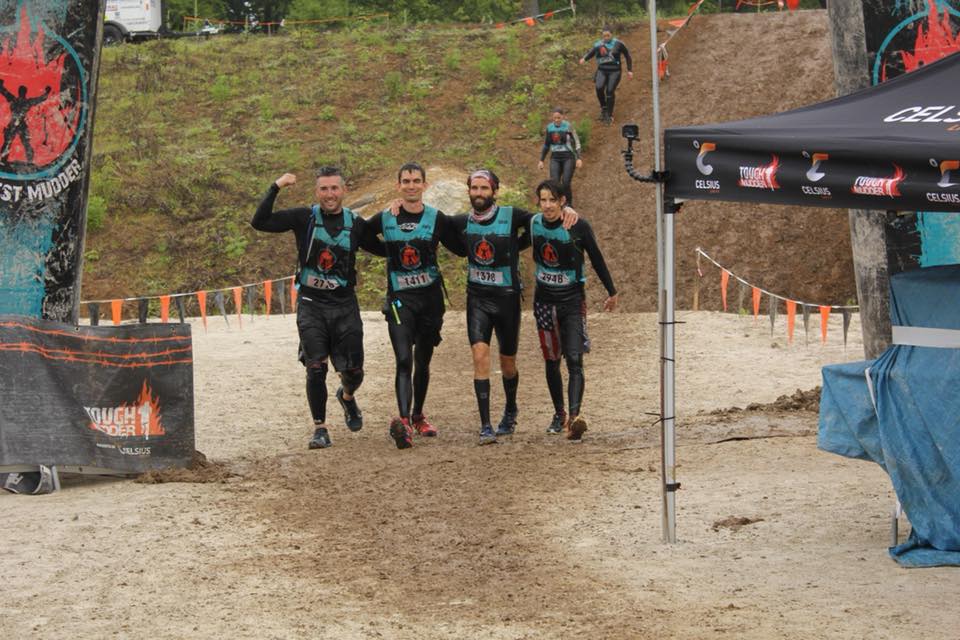At the end of 2018, Tough Mudder announced they were changing their 8-hour, multi-lap Toughest Mudder event into a 12-hour event. Included in the changes is another four hours of “fun”, a pit more similar to World’s Toughest Mudder (i.e. tents instead of a spot on a table) and options for relay teams. (Actually, it is only 3.5 hours more of “fun” because gone is the 30 minute grace period where you could still finish a lap at 8.5 hours, instead it is a hard 12-hour cutoff.) Rather than focusing on those changes, I’m going to focus on performance for this article.
Specifically, what happens to an athlete’s performance with the additional four hours? Previously, I’ve discussed my X Toughest (8-hour) Mileage = 2x WTM Mileage equation and the 10-hour rule (your mileage at a 24 hour OCR is 2x your mileage at the 10-hour point).
So with the help of Gary Shaw, my OCR statistician, we looked athlete performance at 8-hour Toughest Philly in 2017 vs. 12-hour Toughest Philly in 2019. We looked at the race population as a whole for this article by comparing averages and performances between 2017 and 2019.
Here are some of the results:
So if you ran X miles in 2017/2018 Toughest, what should that equal in 2019 Toughest? I started with myself and then did a comparison. For the 8-hour Toughest events, I ran either 40 (four times) or 45 miles (twice). For the 12-hour, I’ve only done one so far with 55 miles, but I was holding a consistent pace and given the right course I think 60 is definitely within my personal reach. So using 40 miles and 55 miles as my comparison the formula looks like:
12 Hour performance = 1.33 x 8 Hour Performance
However, when I looked at the general population using averages the formula looks more like:
12 Hour performance = 1.49 x 8 Hour Performance
Normally, here I would talk about degradation in performance and how you should adjust your goals based off an additional four hours of running. However, the data seems to show that for most of the field their 8-hour pace is not much different than their 12-hour pace.
I expected to see a large drop off in mileage after contender status like you see for 2017. After people hit their 5th lap (25 miles), they decided not to go back out for another one. In 2017, you received a 25-mile patch at the conclusion if you hit 25 or more regardless if you reached 35, 40 or 45. However, the field in 2019, seemed to be more focused on mileage than contender status. There is a drop off– females after 35 miles and males after 40 miles– but it is much less pronounced than in 2017. Could this be a result of mileage patches for every 5 miles? Or maybe just a more motivated field?
What’s the big lesson from this? Athletes at Toughest Mudder appear to have an “endurance pace” that doesn’t differ too much between 8 hours and 12 hours. What the data doesn’t show is how fast much of the field starts off at sprinting out of the gate. I was in about 30th at the end of the first lap but finished 3rd. While you can run a little bit faster on that first lap, I would avoid putting yourself into too much a physical deficit, which will be hard to recover from. 12 hours is a long time, pace yourself, stay consistent, stay motivated and above all keep moving. You’ll find yourself at the finish line before you know it.
Want more great tips? Pick up a copy of Mud Run Guide’s Ultra-OCR Bible, the only training book for Ultra-OCR (now available in hard copy and digital). Plus, check out “Ultra-OCR Man: From Special Forces Soldier to Record-Setting OCR Athlete”, which takes the lessons from the Ultra-OCR Bible and provides real-world examples through a biography of ultra-athlete (now available in hard copy and digital).
Thanks to Gary Shaw for assembling this data. Look for more articles from the two of us in the future taking a statistical look at the sport.
Pictures pulled from the Mud Run Guide archives.
Disclaimer: The viewpoints expressed by the authors do not necessarily reflect the opinions, viewpoints and official policies of Mud Run Guide LLC, or their staff. The comments posted on this Website are solely the opinions of the posters.







Leave A Comment